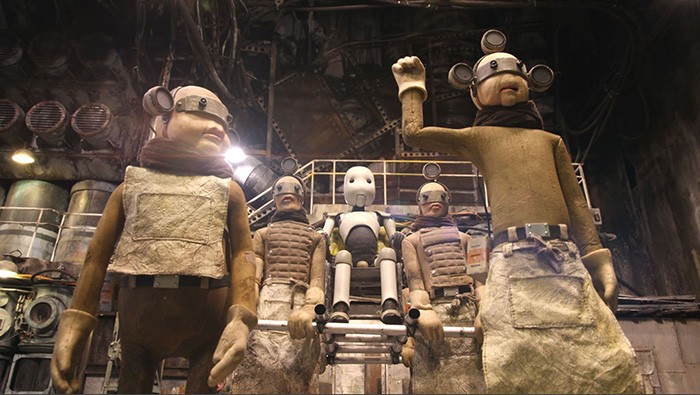After finding acclaim with stop-motion animated short Junk Head 1 in 2014, writer/director/animator Takahide Hori decided to expand its science fiction-infused world to feature length. The result is a two-hour adventure following one man’s descent through a subterranean infrastructure built by clones entitled simply Junk Head. It takes place centuries into our future and centuries more since the clone work force we created rebelled and disappeared underground. Both they and humanity have since evolved into forms neither would recognize, mutations proving to be man’s sole avenue for pushing forward after losing the ability to reproduce. So this expedition into the depths of the unknown isn’t taken lightly. If mankind’s emissary doesn’t return with the correct genetic material (from a creature photographed as still having a penis), our future is lost.

It’s a wild ride pitting the living against the alive as we meet humans, clones (humanoid or xenomorphoid), and sentient robots alike. Our assumption is that these two sides hate each other enough to render this scientific endeavor into a hostile show of force. However, just because humanity sends a volunteer (we’ll simply call him “God”) down in what looks like a missile doesn’t mean it’s an attack. And just because the clones see it falling and decide to shoot it out of the “sky” (we’re miles below ground now) doesn’t mean they’re anticipating an invasion. If anything these actions are taken without premeditation or thought whatsoever. Nothing that occurs in Hori’s fantastical carnival of horrors does. Everything is knee-jerk cause and effect for better or (mostly) worse.
“God” has the misfortune of being dismembered in the “attack,” hitting the ground near a trio of scavenging clones that look like plump SCUBA divers. They scoop him up to show their “Doctor” friend who in turn discovers his human head within the armored helmet protecting it from what we can only assume is pollution above ground. “Doctor” works his magic to transfer “God’s” head onto a new body of scrap strewn about an environment best described as labyrinthine junkyard. “God” has no memory of his identity or his mission, only that this new body and face don’t quite fit. He’ll soon find himself combating dangerous foes and idiotic bullies, each interaction supplying memories via déjà vu and new metamorphoses depending on what finds his decapitated head next.

The plot isn’t therefore very sophisticated. In fact, most of the runtime feels like cobbled together episodes of unfortunate adventures leading “God” farther down towards the center of Earth. Just when we think he’s been saved, his life is jeopardized yet again. In a stroke of luck, however, “God” becoming a sentient robot might prove his salvation since the beasties crawling and scowling in the darkness have no appetite for plastic or metal. While they rip apart the flesh of “normal” clones or eye-less alien-like mutations with varying numbers of legs such as themselves with glee, “God” has a way of instantaneously triggering their gag-reflex. That doesn’t mean they won’t spit him into a chasm and let him break apart into pieces when he hits rock bottom, though.
In this way the film is less about “God” surviving or completing his mission — the penis-waving monster is something of a pet to his newfound SCUBA diving chums — and more about soaking in the awe-inspiring world he now inhabits. Hori has outdone himself with massive sets of rock, rebar, metal mesh, and factory-like systems operated by humanoid clones in masks. The easiest comparison to make would be LAIKA studios and their own meticulous attention to detail, but that doesn’t do its surrealist tone of darkly imaginative demons justice. To me Junk Head most resembles the music videos of Tool that band member Adam Jones directs. Pump some of their industrial metal melodies into the theater and Hori’s aesthetic should fit perfectly. Clarity becomes an afterthought to unforgettable visuals.

So, even as “God” is remade three times, we never truly get bored because the repetition of events is tempered by a unique discovery of characters. The monsters grow larger as we go and “God’s” allies become more diverse. He’s not immune to being conned out of “mashrooms” or touched by compassion (a young, prideful girl eventually follows him before revealing her own past through flashback). You could say that “God” is learning more about himself down here than he ever did up there. He’s being reminded about what it is to live and sacrifice. He’s learning that the things human’s believe don’t supply the full story and that the clones may in fact be more human than anyone he’s ever met. Each rebirth expands his consciousness.
The whole could be improved with some tweaking story-wise, but I can’t fault any of the characters or set designs (and therefore can’t suggest places to cut since the bloat often provides its most memorable creatures). Whether it’s the gorgeous tree monsters of hardened bark that grow into real trees upon death or those plump SCUBA men injecting a drug that renders them muscular enough to stretch their rubber suits taut, we’ve entered Quay Brothers territory as far as each maquette being a work of art in itself. There are as many gruesome scenes as physically comedic farce so while a bit more world building exposition would have been nice, Hori shows his bottomless creativity regardless as his “God” explores infinite caverns man has not yet seen.
Junk Head screened at the Fantasia International Film Festival.

